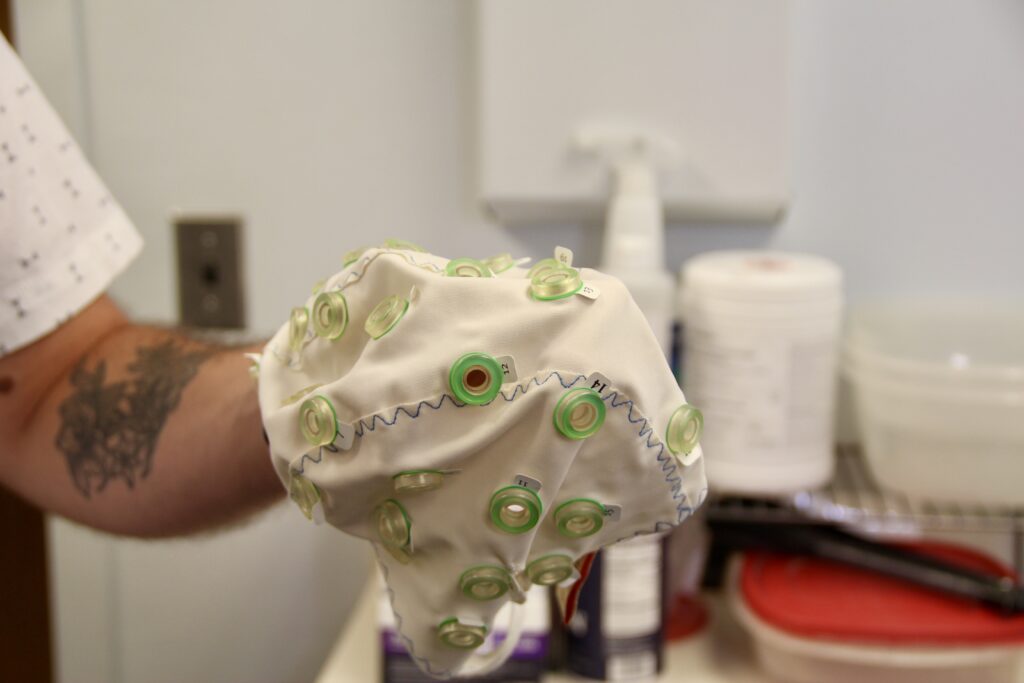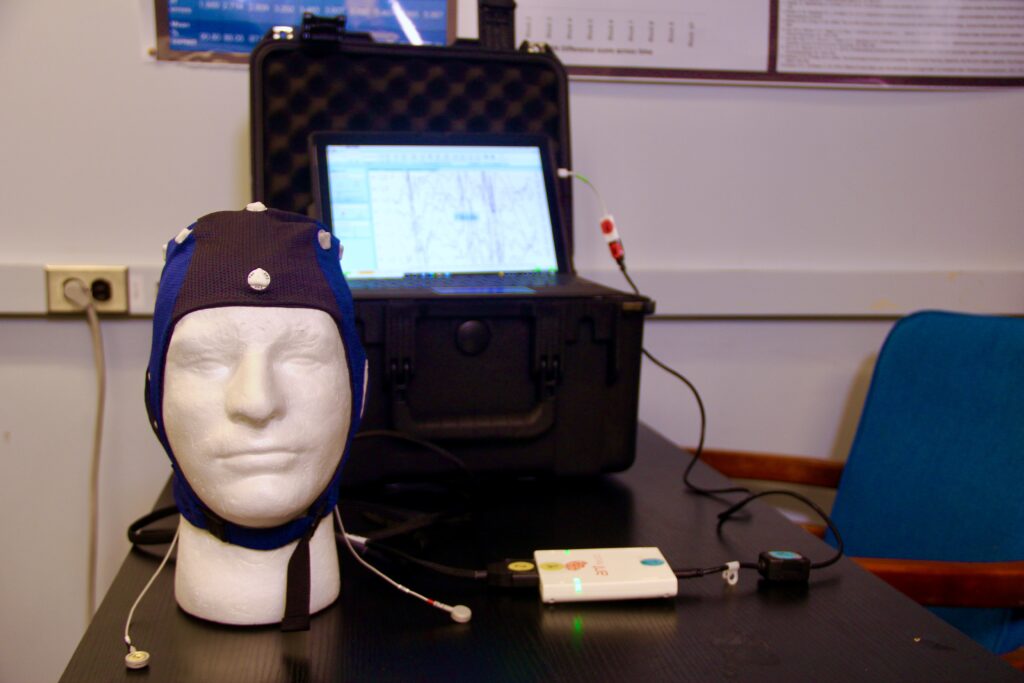Lab Culture: PACER Lab
By Tim Brouk, tbrouk@purdue.edu
Electroencephalography, better known as EEG, measures tiny electrical charges caused by brain cell activity. While the name is long, the image of patients wearing numerous electrodes pasted to their scalp is vivid.
Small metal discs at the end of the electrodes must usually touch the patient’s skin. In the Purdue University Laboratory for the Psychophysiological Analysis of Cognition, Emotion, and Reward (PACER), Daniel Foti, associate professor of clinical psychology and neuroscience in the Purdue Department of Psychological Sciences, uses a less invasive approach with his research participants to measure their brain activity.
PACER participants don a stretchy Lycra cap, which looks and fits like a swimmer’s cap, featuring small holes where the electrodes and their silver chloride tips come within one millimeter of the participant’s scalp. Green Electro-Gel bridges that tiny gap binding the electrode with the participant’s skin and accurately measures brain activity in real time.
“It records brain activity in microvolts, and it records brain activity every other millisecond,” Foti said. “That’s as close as we can get in measuring brain activity directly. It’s a pretty powerful technique in that regard.”

Daniel Foti, associate professor of clinical psychology and neuroscience, holds an EEG cap in the testing room of PACER Lab.Tim Brouk

PACER Lab’s EEG caps fit like a swimmer’s cap. 
PACER Lab electrodes are inserted into the cap one millimeter from the scalp.
Foti’s latest work concentrates on diagnosing depression and schizophrenia at its early stages as well as how the brain is affected by such mood and neurological disorders.
“Clinically, there is a need for relatively objective markers and processes that can help make things like diagnosis more accurate as well as risk prediction,” Foti said.
They’re gellin’
After a consultation, a PACER Lab research participant is fitted with the EEG cap as gel is injected into the cap with a syringe. The participant sits in a soundproof booth with a window, so Foti or his student researchers can observe a live feed of brain activity on their computer screens. They must wait for each electrode to signal green on the monitor before testing can begin.
Brainwaves are then illustrated on the computer monitor. Stress levels within the patient are evident as well as neurological reactions to simple physical tasks like blinking or swallowing.
Results from these tests have fueled recent published studies on how EEG compares with other brain activity measurement techniques, such as functional magnetic resonance imaging, the psychometric properties of EEG and the technique’s use as a patient assessment tool.
Remote EEG

Doctoral student Roz Harold holds the cap of her portable EEG kit, which was mailed to a participant with Angelman syndrome. 
The kit arrives almost ready to go to record brain activity.
While masked, healthy participants returned to the PACER Lab this summer. The COVID-19 pandemic inspired doctoral students Roz Harold and Kim Galvez-Ortega to create portable EEG system kits shipped to research participants all over the country. Co-led by Bridgette Kelleher, Purdue associate professor in Psychological Sciences, the students’ current focus is on families affected by Angelman syndrome, a rare genetic disorder that delays development and affects speech, balance and intellect.
The first kit shipped a few weeks ago. Harold and Galvez-Ortega’s data sets can now expand with the implantation of the kits as Angelman only affects one in about 10,000 people.
“It can be challenging to include these families in in-person research studies because there’s just not very many of them in any given town, especially a smaller town like Lafayette,” Harold said.
A plastic case about the size of a sewing machine is filled with a cap already connected to electrodes and wired to a tablet. No gel is used. Silicone tips built in the cap measures the brain activity. The software is already loaded into the device and a short consultation over the phone gets the participant ready to execute their own EEG tests. The kit is then returned to PACER Lab, and the data is downloaded for analysis.
Avengers assemble … in the PACER Lab!
Foti’s research in the field of neurological discoveries in mental health has been superhero-like so far, so it’s only fitting some of Marvel’s best are represented in the PACER Lab.
A greeting card for a 5-year-old’s birthday was repurposed for the PACER Lab’s fifth anniversary and is still prominently displayed. It features Captain America ready for battle, while circular wooden laser cuts of the Incredible Hulk and Thor hang on the hard drives of some of the students’ workstations. Foti said a former student who dabbled in laser cutting gifted him the pieces, one of the many examples of students leaving their lasting mark on his lab.
“To me, the lab is like this organic place, this living place that continues to grow as folks come here for a time and rotate through,” Foti said. “The culture is always changing, too. The culture is dependent on whoever is here at the time, and that’s always cool to see.”

PACER Lab’s brain clock and the word cloud shaped like a brain are examples of gifts left by student researchers after graduation.Tim Brouk
Discover more from News | College of Health and Human Sciences
Subscribe to get the latest posts sent to your email.